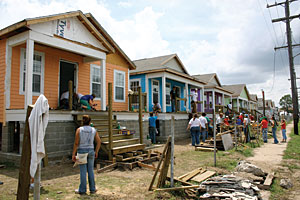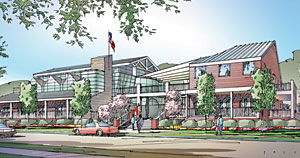In the months following Hurricane Katrina, two well-connected musicians, Harry Connick, Jr., and Branford Marsalis, began thinking about how they could help New Orleans’s music scene recover. They soon teamed with Habitat for Humanity to envision Musicians’ Village: a neighborhood composed of 70 single-family homes, five duplexes, a park, and a performance center, that would provide musicians with affordable housing and work space. The move from cultural mission to concrete buildings has not been as simple—or as musical—as they initially hoped it would be, but it is finally showing success.

The Ellis Marsalis Center for Music will anchor Habitat for Humanity’s new Musicians’ Village in the Ninth Ward.

Image courtesy Mathes Brierre Architects
Musicians’ Village is located on an 8-acre site in the Upper Ninth Ward. At its heart will be a 250-seat music hall. Designed by the local firm Mathes Brierre Architects, the 15,000-square-foot Ellis Marsalis Center for Music (named for the pianist and patriarch of the famed Marsalis clan) pursues a contemporary glass-and-brick aesthetic in a neighborhood characterized by clapboard structures. Generous fenestration will let in plenty of daylight—which, coupled with photovoltaic cells generating the building’s electricity, could qualify the project for LEED Gold certification. Construction is set to begin in September.
Roughly half of the residences, meanwhile, are already complete. Habitat began building the Village in 2006, still in emergency mode, concentrating on putting up structures as quickly as possible. The first few were nearly identical, differentiated mostly by their bright colors. But as construction progressed, Michael Bell, principal of Bell Architects, began introducing variation. He upped the ceiling height and pitch of Habitat’s standard model to produce a design that more closely resembles the local shotgun vernacular. He also created a greater variety of footprints and added simplified versions of traditional Arts and Crafts detailing.
Construction on the remaining residences begins this month and is expected to finish in November. Bell sees the flexibility of his design as a function of the village itself, which he describes as an “urban planning and policy experiment.”
But the experiment has hit a few wrong notes. Credit problems and a lengthy application process discouraged many musicians from buying in the village. Moreover, fair housing laws prevent Habitat from selling to only a specific type of person. In response, the nonprofit group relaxed its application process by accepting performance records instead of pay stubs and allowing musicians to work less than the 350 hours of “sweat equity” it usually requires of new homeowners. It’s also now aiming for a 60:40 ratio of musicians to other residents.

Post a comment to this article
Report Abusive Comment